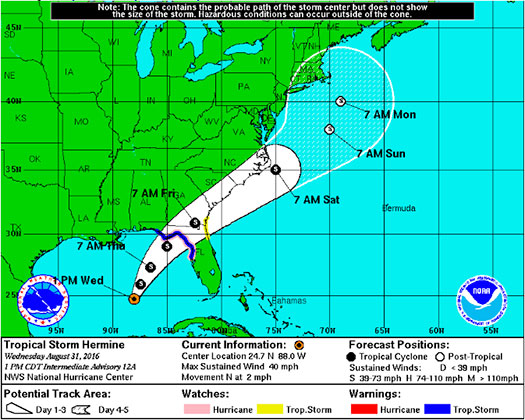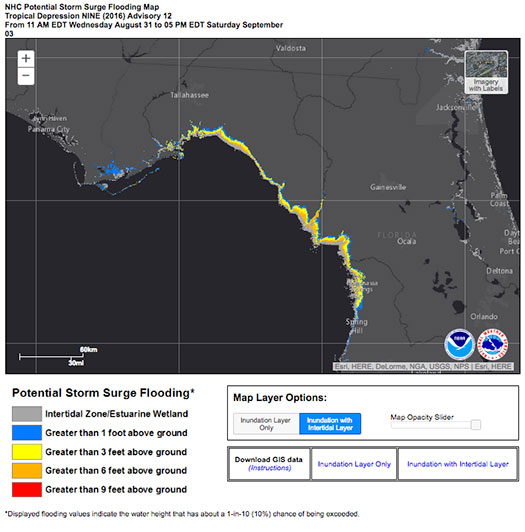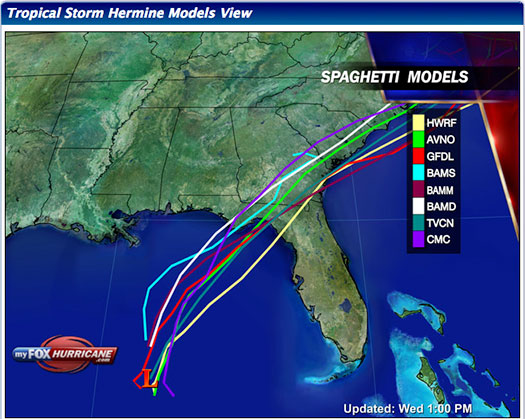Moderate
Latest from the National Hurricane Center:
“Hermine appears to be drifting northward near 2 mph (4 km/h). A north-northeastward motion is expected later today, and a turn toward the northeast with increasing forward speed is expected on Thursday. On the forecast track, the center of Hermine will approach the northwest Florida coast in the warning area on Thursday afternoon.”



FMIT Discussion
-
Tropical Storm Hermine continues to strengthen as it progresses through the Gulf of Mexico towards Florida with movement speed expected to increase by tomorrow.
-
A hurricane watch and tropical storm warning have been issued by NHC for Florida’s Gulf Coast including the Big Bend and Panhandle.
-
Wind speeds have increased to 40 mph and are expected to grow to 50 mph by later tonight and up to 65 mph prior to landfall this week.
-
Heavy amounts of rainfall are currently affecting portions of FL (St. Petersburg) prior to the storm, so additional rains from TS Hermine (5”-8”) will make flooding in very likely due to additional rain in already flooded/saturated areas. Some areas may see as much as 15″ of isolated downpours over the next 24-48 hrs.
-
Hermine also carries high potential for the development of isolated tornadoes primarily along the eastern side of the storm as it moves over the peninsula.
-
Areas of Coastal FL subject to potential storm surge flooding due to winds pushing sea water toward the coast. Estimates are from 3’ to 6’ or more in some low lying areas.
-
The FMIT Claims Team in Orlando is currently preparing for potential landfall.
-
TrackDown Damage Assessment login information will be sent to Members in the potential affected area for documenting losses to fixed property.
Still to Watch:
Tropical Storm Hermine is projected to increase in intensity and make landfall by tomorrow. Winds have increased to 40 mph and are projected to continue to increase as convection around the low is forecast to increase as the week goes on. Areas of North Central, Big Bend, and the Panhandle should maintain a watchful eye on the storm as the week progresses.
FMIT Member Preparedness Actions
-
Ride Out teams are positioned in Fort Myers, Tampa, Oldsmar and Tallahassee areas to assist Members with the response and recovery process. FMIT’s Property Insurance Policy affords many benefits to its members.
-
Members should continue to monitor the storm as well as FMIT Alerts and local/national weather forecasts.
-
Members throughout the western coast of FL should begin preparations for potential landfall later this week, which may include communications with internal emergency response leadership.
-
Complete any mitigation procedures prior to the storm’s arrival as safe to do so.
-
If not completed already, move or disassemble mobile or other assets susceptible to wind damage. These include: Portable & Fixed Shade Structures, Canopies, Awnings, Mobile Trash Cans, Umbrellas, Flag Poles, Tables/Benches Not Affixed to the Ground, Soccer Goals, etc…
-
Finalize the installation of any preventive instruments used to protect assets from high winds & heavy rain, such as Hurricane Shutters over windows.
-
Complete necessary preventive maintenance and vegetation removal from drains and ensure proper operation and maintenance of lift station and pump stations to minimize the influx of debris into the water and sewer management systems.
-
If utilizing the FMIT Turnkey Recovery program, please review any contracts you currently have with companies that provide emergency response products & services and contact them to notify them that they will be required to perform work under the coordination of the FMIT Turnkey Recovery program to ensure all losses and associated costs are properly managed and submitted through your insurer and FEMA for proper potential reimbursement.
-
Review Critical Assets that would be most susceptible to damage from an impending hurricane while being critical to municipal operations. Be prepared to share this list and potential mitigation procedures with Synergy/FMIT in advance of the storm. Critical Assets generally include Water Treatment Plant Assets, Critical Community Facilities, etc…
-
Ensure that any coastal assets close to the ocean (lifeguard stands, park equipment, etc…) have been moved away from potential storm surge levels.
